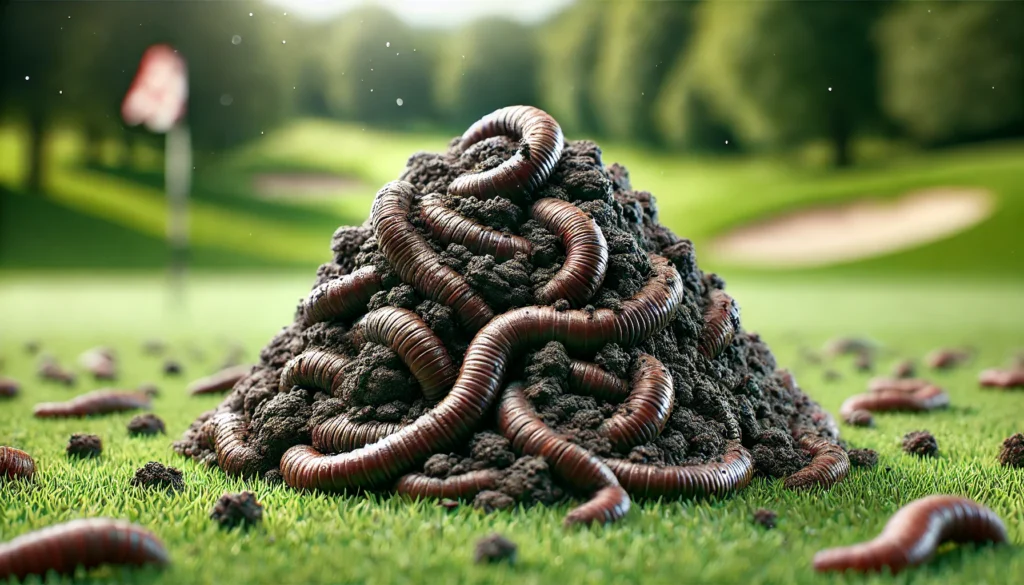
Golf course earthworm casting has become an increasingly major challenge for maintenance teams.
So much so that the Sports Turf Research Institute rated earthworm casts as its main source of problem-based queries.
Meanwhile, greenkeepers worldwide search for solutions amid growing pressure from golfers and club committees.
But don’t worry. Carr Golf is here to help.
In this article, you’ll learn:
- What earthworm casting is
- Why it’s increasingly common
- The problems it causes
- Our top tips to tackle earthworm casts
- How earthworms benefit golf courses
Golf course earthworm casting explained
So, what is earthworm casting?
Earthworms ingest soil and organic matter and then deposit the resulting faecal matter as mounds on the soil surfaces of golf courses.
Typically, these ‘casts’ gather in high-moisture, well-aerated and nutrient-rich areas.
This usually means high-traffic zones such as greens, fairways and tees.
Interestingly, these specific areas – as our survey revealed – matter a great deal to the average golfer.
Why earthworm casts have become more widespread
Historically, pesticides decimated earthworm populations. So it would take years for the casting problems to reoccur.
However, once the residues of these strong chemicals dissipate in soils, the earthworm population surges.
As a result, so does the number of casts on the golf course.
The use of Carbendazim – a fungicide – provided some relief. Although, it was an unintended side effect that deterred casting earthworms from surface activity.
But Carbendazim was deregistered in the Republic of Ireland.
Then the UK followed suit.
Problems earthworm casts cause golf courses
You can look at earthworm casting as a we’re-all-in-this-together problem for your golf club.
Because it affects golfers, greenkeepers and management.
Golf course earthworm casts:
- Disrupt ball rolls and lies
- Obstruct and complicate shots
- Affect surface smoothness and firmness
- Require constant sweeping and brushing
- Compact, erode and spread soil
- Cause weed growth and turf damange
- Clog and blunt mower blades
4 tips to tackle golf course earthworm casting
Carr Golf has been overseeing golf course maintenance operations at clubs and venues across Ireland since 2010.
Over the years, our expert team have helped greenkeepers reduce earthworm casts on their golf courses.
Let’s take a look at our most effective strategies.
1. Collect your grass clippings
Reducing the availability of food influences the population of earthworms. Returning grass clippings during mowing creates a limitless supply of organic matter for earthworms to feed on.
Collecting or boxing off clippings on fine surfaces reduces the casting problem.
This simplte but effective strategy worked very well for Carr Golf at clubs such as Royal Curragh and Foxrock.
2. Undertake a fairway topdressing program
Earthworm populations are highest in light and medium-textured loam soils. These soils are commonplace throughout Ireland.
Smaller populations also exist in coarse, abrasive, sandy soils, such as those found on golf course greens.
The abrasiveness of sand particles and the susceptibility of such soils to drought can influence the species composition and population.
But our fairway topdressing program at Castleknock Golf Club all but eliminated the problem.
3. Try tea seed oil
Carr Golf has trialled tea seed oil with some positive results.
This can be an effective approach to managing the casting problem, though efficacy depends on the organic matter content of the soil and environmental factors.
Note: The resulting accumulation of dead earthworms on the surface should be removed promptly for the benefit of golfers!
4. Use ammonium sulphate fertilisers
Research in the US has reported a direct correlation between declines in the earthworm populations and declining soil pH or increasing acidity.
From our experience, this is evident in Ireland where earthworm populations are typically low on the acidic, peaty soils found in bogs.
Therefore, using sulphate-based fertilisers is beneficial by increasing acidity at the soil surface. We are trialling a sulphur-based product at the moment with a similar intention at a number of our golf courses.
But it’s not all bad news……
How earthworms help your golf course
The vast majority of the earthworm species native to Ireland do not create casts.
In fact, a healthy earthworm population can benefit your golf course.
Earthworm tunnels:
- Relieve soil compaction and create passageways
- Break downs thatch accumulations on the turf
This helps to accelerate air and water percolation as well as nutrient recycling. All of which improve the functional and visual quality of playing surfaces.
Ultimately, earthworms provide more benefits than harm to our golf courses. So we need to learn to live with our little friends.
The more we understand this issue, the better we can manage it. But our 4 tips for tackling golf course earthworm casting is a good place to start.
Click here to read the original 2019 article by Ed Pettit, Managing Director of Carr Golf.
